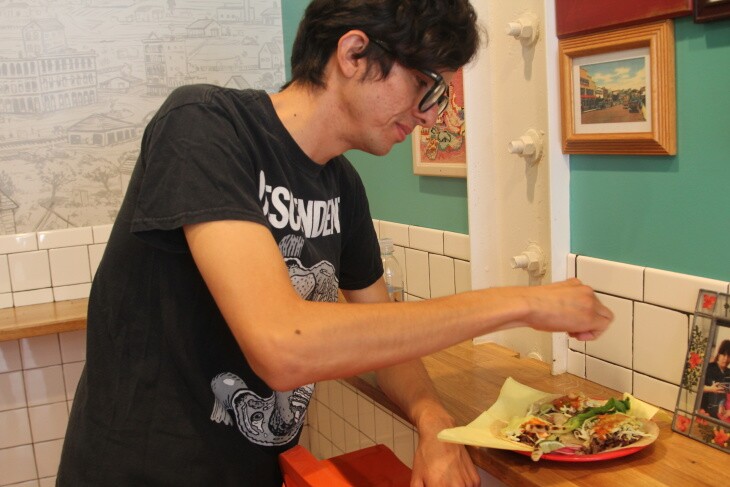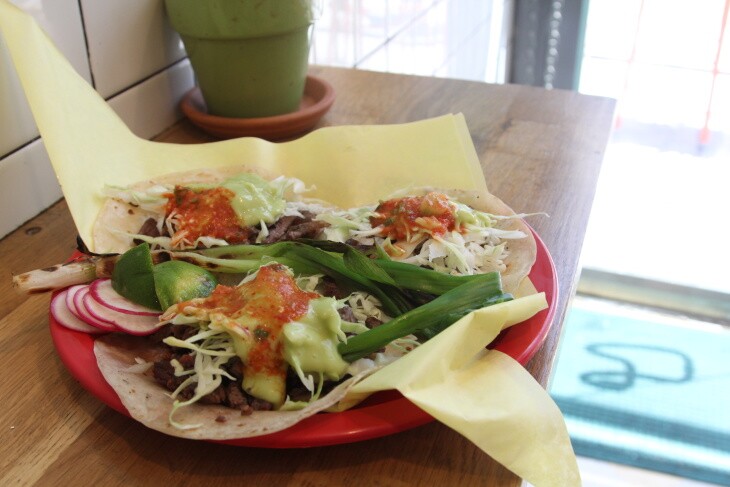Truth matters. Community matters. Your support makes both possible. LAist is one of the few places where news remains independent and free from political and corporate influence. Stand up for truth and for LAist. Make your year-end tax-deductible gift now.
Meet The Taco Scout Who Found All Of 'Taco Chronicles' Best Eats

Javier Cabral has one of the best gigs on the planet. As the taco scout and associate producer of Netflix's new Spanish-language series, Las Crónicas Del Taco or Taco Chronicles, he spent most of 2018 traveling to Mexico, sometimes stopping at as many as 17 taquerias a day, to find the most delectable carnitas, asada, barbacoa, canasta, guisado and pastor, the six types of tacos that each receive a dedicated episode on the show.
He also helped coordinate production with Sonoratown and Guerrilla Tacos, the only restaurants outside of Mexico featured on the show, both in Cabral's (and our) hometown of Los Angeles.
So what does it take to be a taco scout? How did Cabral get crowned the taco kingmaker? And how did these two L.A. spots make the cut?

WHAT IT TAKES TO BE A TACO SCOUT
"I've been doing food writing seriously and professionally for almost fifteen years now," Cabral says. "I am Mexican American and there aren't too many of us who specialize in food writing."
Cabral identified three crucial traits for the aspiring taco scout:
- "You have to have a gut of steel."
- "You have to have a hyper crazy active metabolism, a.k.a., have a lot of anxiety like I do."
- "Be persistent. Even in Mexico, there are a lot of bad tacos."
If you still think you could hack the taco scout life, be warned: It involves sacrifice.
"I sometimes wanted some fresh fruit but you have to use each inch of stomach space carefully. This is part of the art of eating to work. You have to have a great sense of willpower to not eat a whole taco, even if it's amazing," he says.
It also took time for him to develop trust with the taqueros, to prove that he wasn't a con artist and wasn't trying to steal their recipes.
HOW DOES A TACO MAKE THE CUT?
"Have you ever taken a bite of something and you just get this sense of euphoria?"
That is Cabral's exacting standard, both maddeningly broad and exceedingly specific.
"This usually translates into a taquero who does not take shortcuts, who either makes their tortillas by hand or uses a tortilla from 100% nixtamal," he says.
Cabral is super serious about the tortilla. He likens it to pasta or crusty french bread in a quality sandwich. Sometimes overlooked (or even worse, store bought), a fresh, handmade tortilla is a must if you want to achieve taco greatness.
When scouting locations for the show, Cabral said he also looked for colorful personalities, unique flavors and people who had an emotional connection to their food.

WHAT MAKES TACO CHRONICLES SIGNIFICANT?
This is Netflix's first mainstream food show entirely in Spanish and it celebrates every aspect of the taco, from the butchers who provide pork for the al pastor to the history of each regional variation.
"It's a show that could be a reference, a chronicle of what each taco is," says Pablo Cruz, the creator and executive producer of Taco Chronicles. "And for someone who's never heard of tacos, it's a representation of Mexico in a tortilla."
One of the most unique aspects of the show is its format. Instead of a host, the show is narrated by personified tacos.
"There are so many shows that are hosted and people want to inject their opinion or perspective, you know, outsider looking in. But this series, it's a taco that is reflecting in its history and a taco looking out into its future and evolution," Cabral says.
This show trains its focus on the people who prepare the tacos.
"We wanted to celebrate the working class taquero who burns their hand every day and has calluses on their fingers," Cabral says.

THE JONATHAN GOLD(EN) TOUCH
Cabral got his start in food writing when he was just fifteen years old, and it all started during his commute to high school, which he spent reading L.A. Weekly.
"I would read it to find out about punk shows," Cabral says. While doing that, he stumbled on the writing of Jonathan Gold, who was the restaurant critic for the alt-weekly at the time.
"I realized that essentially, this guy gets paid to eat. How punk rock is that?"
One cold email to Jonathan Gold later, and Cabral started up a relationship with one of L.A.'s most iconic food critics. In 2012, the Los Angeles Times asked Cabral to be Gold's restaurant scout.
"I think the paper realized, he's only one belly," Cabral says. "A big belly, but still only one belly."
Fifteen years later, Cabral has written for publications from Food & Wine to Saveur. He's also the associate editor for local news and culture site L.A. Taco. If that wasn't enough, his first cookbook on Oaxacan cuisine, which he was writing while scouting Taco Chronicles, comes out this fall.

WHY SONORATOWN?
Only two restaurants outside of Mexico made it into Taco Chronicles. One of them is Sonoratown, located in downtown L.A.'s fashion district. You'll find it in episode 4, "Asada."
"It really is the best carne asada in L.A.," Cabral says.
Owned by Jennifer Feltham and Teodoro Diaz-Rodriguez, Sonoratown recreates the food from Diaz-Rodriguez's hometown of San Luis Río Colorado in the northern Mexican state of Sonora.
"Meat is king," Feltham says. "So we really pride ourselves in using a fine quality cut of beef for our carne asada. We use short rib or costilla."
The Sonoran desert is filled with mesquite and everything at Sonoratown, from the beef to the charred green onions, is infused with its perfume as it passes over the wood flame grill.
Then there are the tortillas. They're wheat and to achieve the perfect thin, airy and chewy texture, Fletham and Diaz-Rodriguez drive to Sonora twice per month to buy sacks of Sonoran flour.
Cabral points out that the resulting creation has all the elements of a "proper" carne asada plate: a piece of paper under the tacos to keep the dish clean, grilled green onions, limes, thinly sliced radishes and, of course, the tacos themselves.

A MODERN DAY GUISADO
On the flipside of the true-to-tradition Sonoratown is Guerrilla Tacos, chef Wesley Avila's taco venture which started as a cart seven years ago and is now a slick brick-and-mortar in the Arts District.
While guisado tacos are often thought of as containing a stew, Cabral says its a regional specialty that takes advantage of local ingredients. That's why you'll see Guerrilla Tacos in the guisado episode.
Avila's popular sweet potato taco is an apt encapsulation of a modern guisados: salty, caramelized sweet potatoes with almond chile, feta cheese, scallions, salsa and corn nuts on a blue corn tortilla, made by Kernel of Truth in Boyle Heights.

Some critics say Avila's tacos aren't "authentic" Mexican food.
"I'm like, you're right!" Avila says. "I'm not doing authentic Mexican food. My food is authentic to Los Angeles and I try to play true to its strengths of being a melting pot. My food reflects that."
Cruz, the creator of Taco Chronicles, echoes the sentiment.
"Wes has reinterpreted his culture and references he's had since he was a kid and made them universal," Cruz says. "He has put tacos on another level, and another price as well."
Each taco costs $5 to $6, another criticism Avila sometimes faces. But for him, the quality and freshness of his ingredients, which are locally sourced, justifies the cost.
Cabral, who has written ardently in defense of the upscale taco, says: "I want people to take tacos seriously, because no one trips out on paying more than 20 bucks for a bowl of flour and water in the form of pasta. But sometimes, you have some nice tacos that are that same price range and everyone's like 'Oh my god, that's so expensive!' But tacos are an art and they're meant to evolve."
Whether you're an aspiring taco scout or a humble foodie looking for the tastiest bites, Cabral's has some words of wisdom.
"Keep an open mind, support your local taquero and remember, tacos will always be there for you."








